Sartorial Sense and Sensibility: Dressing Elinor and Marianne

It may not hold the same universal affection as Pride and Prejudice but Sense and Sensibility, Jane Austen’s first novel, displays all the wit and intelligence that captivated readers in the succeeding five. Two strong female leads, with a story of noisy passion versus quiet longing, appeals to a wide spectrum of readers and portrays romantic experiences that most audiences can relate to.
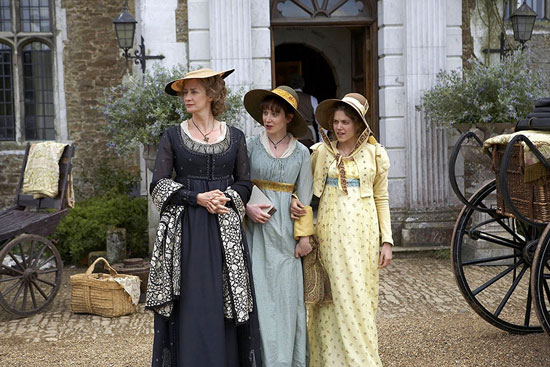
To help keep this site running: Willow and Thatch may receive a commission when you click on any of the links on our site and make a purchase after doing so.
When the Dashwood sisters – Elinor, Marianne, and Margaret – along with their mother are ousted from their beloved family home, Norland, by their spineless brother John and his gruesome wife, Fanny, they are forced to take up a far more frugal existence in the Devon countryside. This uprooting from grand country seat to quaint cottage offers a rich mood-board for TV and film designers, and creates opportunities to produce distinct changes in clothing according to personal circumstance.
Moreover, Elinor and Marianne’s polar opposite characters have always provided costume designers with clear sartorial boundaries. In the most recent adaptation of 2008, the younger sister, Marianne is dressed in deeper, richer colours that suggest her passion and creativity, while her older and far more grounded sister, Elinor, wears whites, blues, and browns – earthy colours in plain styles that demonstrate her prudence and prevailing sense of duty.
Austen never wrote in much detail about fashion, which must be both a blessing and a curse for designers; giving them a degree of artistic license but also the lack of precious extant guidance. The most that is said of Marianne’s clothing is that ‘To her dress and appearance she was grown… perfectly indifferent.’ But her passionate and impulsive nature have usually led designers to clothe her in the more youthful and fashionable wardrobe of the two sisters.
Sensible and reserved Elinor is generally dressed attractively, but plainly, and we soon come to realize that Edward Ferrars, her love interest in the book, is not a man easily impressed by fancy fabrics and trimmings. Marianne’s first ill-fated lover, Willoughby, is on the other hand highly fashionable, ambitious and naïve, and in some adaptations Marianne’s dress reflects her wish to embody his interests and pursuits. In this article I’m going to explore the four TV and film dramatisations of Sense and Sensibility, with a view to discussing the contemporary and historical influences for the costuming in each, the portrayal of the two eldest sisters in terms of their clothing, and as ever, the importance (or not) of accuracy. – Lydia Edwards
Sense and Sensibility (1971) BBC
Starring Joanna David and Ciaran Madden
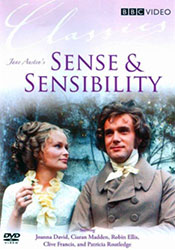 Being the first adaptation to hit the screen (after an hour long, live, 1950 teleplay), it is worth remembering that this series had no significant previous work to draw on. It has been noted that this production, though undeniably stagey in the manner of many 1970s television dramas, nevertheless paved the way for succeeding adaptations in terms of characterization and plot devices. As Professor Ellen Moody has pointed out it was, for example, the first to feature Colonel Brandon at the ball where Marianne is snubbed by Willoughby, something included in both the 1981 and 2008 versions. This is important in that it begins to sow the seeds of Brandon and Marianne’s future romance.
Being the first adaptation to hit the screen (after an hour long, live, 1950 teleplay), it is worth remembering that this series had no significant previous work to draw on. It has been noted that this production, though undeniably stagey in the manner of many 1970s television dramas, nevertheless paved the way for succeeding adaptations in terms of characterization and plot devices. As Professor Ellen Moody has pointed out it was, for example, the first to feature Colonel Brandon at the ball where Marianne is snubbed by Willoughby, something included in both the 1981 and 2008 versions. This is important in that it begins to sow the seeds of Brandon and Marianne’s future romance.
The silent suffering of Elinor is beautifully, painfully expressed in the wide eyes and sad smiles of Joanna David (who incidentally went on to play Mrs Gardiner in the BBC’s Pride and Prejudice, 1995), and this is countered well by the (sometimes overplayed) histrionics of Ciaran Madden as her younger sister. Certain aspects of the costuming are pure late 1960s/early 70s, particularly the women’s bouffant curls and many of the fabric choices for dresses. Marianne’s yellow ruffled broderie anglaise gown, which appears on the DVD cover and other promotional material, is perhaps the most contemporaneous.
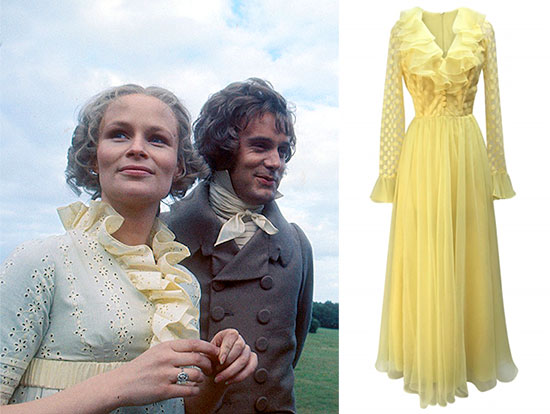
Left: Ciaran Madden in Sense and Sensibility, 1971
Right: Ruffled maxi dress, 1970s, Miss Daisy Blue Vintage
There are certainly other examples of dresses that could be dismissed as ‘of their time’, but looking through fashion plates from c.1809-12 also provides examples of very close approximations of Regency style.
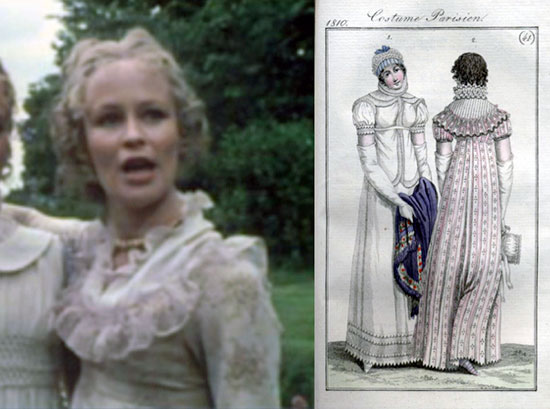
Left: Ciaran Madden in Sense and Sensibility, 1971
Right: Fashion plate, 1810, Costume Parisien
Lucy Steele (played with delightful villainy by Frances Cuka) is the epitome of Regency elegance, with accessories and hats, in particular, which could have been taken directly from a fashion plate of the era:
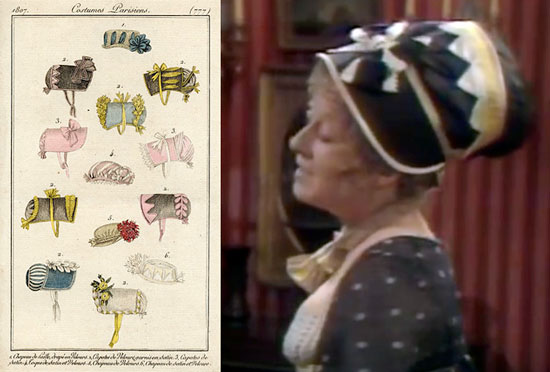
Left: Fashion plate, Journal des Dames et des Modes, January 1807
Right: Frances Cuka in Sense and Sensibility, 1971
As is so often the case with Austen’s characters, those who conform slavishly to the latest trends are those with the weakest moral compass.
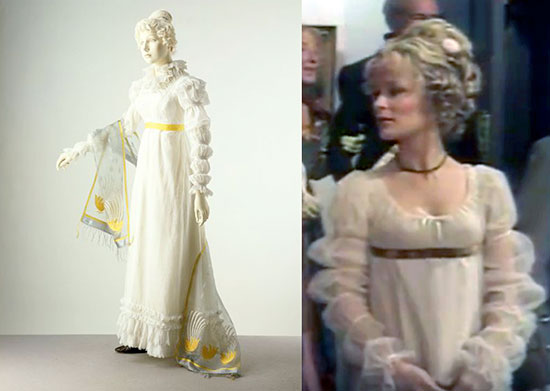
Left: Embroidered muslin dress, 1818, Victoria & Albert Museum, London
Right: Ciaran Madden in Sense and Sensibility, 1971
The very high waistlines of most of the female characters also correspond closely to fashion plates and other illustrations from the era, possibly more so than in later adaptations. Marianne’s mameluke sleeves in one scene are also a nice touch, though more representative of later Regency styles than the c.1811-12 of the adaptation’s setting. Nevertheless they show a close attention to period sources, and a wish to recreate more obscure as well as easily recognizable historic trends.
“Sense and Sensibility” (1971) is AVAILABLE on DVD
Sense and Sensibility (1981) BBC
Starring Tracey Childs and Irene Richard
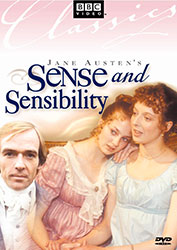 The costumes in this miniseries have been described by one online reviewer as ‘VERY high school costume shop’, and certainly the fabrics used for both Elinor and Marianne lack the period detail of most other adaptations. The stance of the female characters and the fit of their costumes – often with sleeves, in particular, that seem too loose and baggy – also provokes some speculation as to the type of recreation underwear used. This production does carry a different atmosphere and aesthetic to the BBC’s previous of a decade earlier, and there is an element perhaps of ‘playing it safe’ with a palette colour scheme and trimmings that add colour without, necessarily, subtlety or a strong sense of period accuracy:
The costumes in this miniseries have been described by one online reviewer as ‘VERY high school costume shop’, and certainly the fabrics used for both Elinor and Marianne lack the period detail of most other adaptations. The stance of the female characters and the fit of their costumes – often with sleeves, in particular, that seem too loose and baggy – also provokes some speculation as to the type of recreation underwear used. This production does carry a different atmosphere and aesthetic to the BBC’s previous of a decade earlier, and there is an element perhaps of ‘playing it safe’ with a palette colour scheme and trimmings that add colour without, necessarily, subtlety or a strong sense of period accuracy:
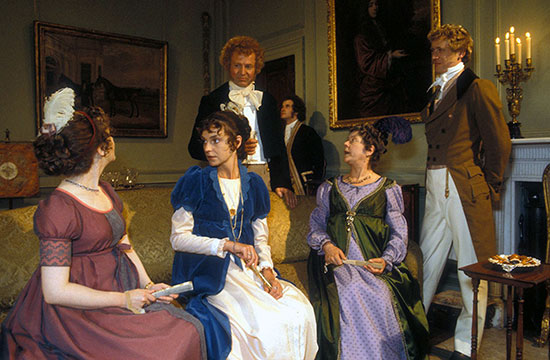
Color scheme in Sense and Sensibility, 1981
Nevertheless, the youthful naivety and optimism of Marianne is well illustrated through her soft pinks, yellows and browns, accompanied by pretty lace collars and sleeve detail. The amount of lace and frill in some ensembles suggests a chosen date of around 1812-15 onwards, but overall the exact time period the designers aimed for is hard to place: the details present in some costumes seem to correspond to a particular span of years, whilst others bear little relation to extant sources.
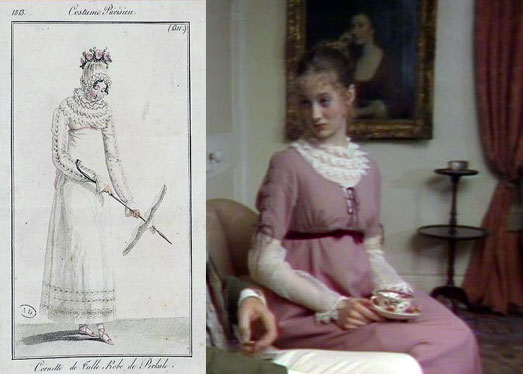
Left: Fashion plate, 1813, Costume Parisien.
Right: Tracey Childs in Sense and Sensibility, 1981
There are some nice stylistic details included, however, that can be found in fashion plates and other artworks from the first twenty years of the century. One is the use of so-called ‘Van Dyck’ trim, triangular points on lace or ribbon that create a striking edging for necklines, sleeves and hems:
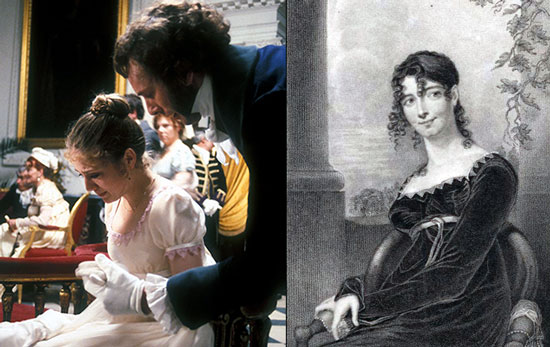
Left: Tracey Childs in Sense and Sensibility, 1981
Right: Moses Haughton, Mrs. H. Johnston, 1812, NYPL Digital Collections
This was named after the 17th-century painter Antony Van Dyck, who frequently used the effect in his portraits, though in the Regency era it was also referred to as ‘saw tooth trim.’
Elinor’s clothes are for the most part more consistent, with less applied decoration, relying on simple lines and plain, un-patterned fabrics to suggest her sensible and steady nature. Her light blue silk evening dress is possibly the most effective, and brings to mind the pretty simplicity of Dinah Collin’s costumes for Pride and Prejudice 14 years later. The mourning dresses that she wears in the beginning of the story are overwhelmingly black, paired with a dark hooded cape that is only broken by the flash of purple from her bonnet. The fact that Marianne is not seen in the same type of mourning – at least not for as long – is slightly unfeasible, but does highlight her free-spirited dislike of convention.
“Sense and Sensibility” (1981) is AVAILABLE to STREAM
Sense and Sensibility (1995)
Starring Emma Thompson and Kate Winslet
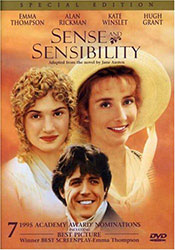 This adaptation was the first (and so far only) film version of the story, and met with considerable success. It arrived during a spate of Austen dramatisations that created something of an obsession with the author and her world, and brought this lesser exposed story into the limelight. It also brought a more contemporary reading of the story through, as Julianne Pidduck (and others) have described it, a ‘popular feminist project’.(Contemporary Costume Film: Space, Place and the Past, London: BFI, p.45)
This adaptation was the first (and so far only) film version of the story, and met with considerable success. It arrived during a spate of Austen dramatisations that created something of an obsession with the author and her world, and brought this lesser exposed story into the limelight. It also brought a more contemporary reading of the story through, as Julianne Pidduck (and others) have described it, a ‘popular feminist project’.(Contemporary Costume Film: Space, Place and the Past, London: BFI, p.45)
Emma Thompson was 36 at the time of filming, considerably older than Elinor Dashwood’s 19. This was conveniently waved away as the role having been ‘re-written’ to make the character older, but in this respect Thompson’s Elinor seems more aunt than older sister to her co-star, and this does affect the feasibility of the story in early 19th century terms. Kate Winslet was closer to the mark at 19, only three years older than Marianne Dashwood.
The costuming in this production is closer to 1790s styles than to the book’s 1811 publication date. As with the 2005 film of Pride and Prejudice, it is set during the period in which Austen was writing although, as seen in Pride and Prejudice’s costumes, the dresses in Sense and Sensibility are cut with much narrower skirts than were fashionable in the 1790s. Round gowns, with their tightly gathered skirts and small bustle pads worn around the waist, were voluminous and, coupled with a very high waist, made for a slightly awkward silhouette. Presumably to be as attractive as possible to a modern audience, Thompson and Winslet’s costumes are more figure-hugging.
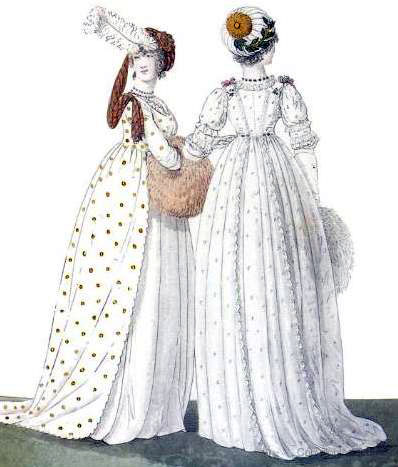
Round gowns, Heideloff Gallery of Fashion, 1794
The lower waistlines also correspond to those of simultaneous Austen adaptations, such as 1995 Pride and Prejudice and Gwyneth Paltrow’s Emma from 1996, both of which had a hand in re-popularizing the empire line during the 1990s. As with the 1971 version, Lucy Steele (played by Imogen Stubbs) embodies fashion-plate glamour and elegance, often wearing quite outré designs that help to isolate her from the rest of the characters.
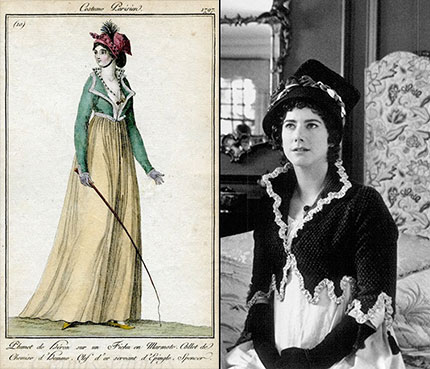
Left: Fashion plate, Costume Parisien, 1797
Right: Imogen Stubbs in Sense and Sensibility, 1995
Several costumes stand out as successfully embodying both a 1790s aesthetic and a more slimline ‘21st century Regency’ accessibility. The first is an open robe, two versions of which appear on both sisters:
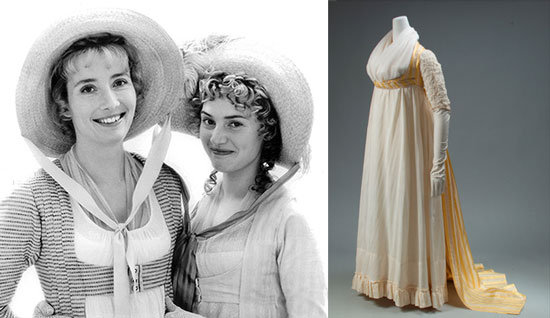
Left: Emma Thompson and Kate Winslet in Sense and Sensibility, 1995
Right: Dress – open robe, c.1795-97, Metropolitan Museum of Art, New York
Jane Austen described what seems to be a similar kind of robe in a letter dated December 1798: ‘I believe I shall make my new gown like my robe, but the back of the latter is all in a piece with the tail’. (Ed. Reginald Brimley Johnson, The Novels and Letters of Jane Austen, New York: Frank S. Holby, 1906, p.262) This suggests that Austen’s ‘robe’ only covered the back of the dress and flowed down into a train, as the top right example shows us. This was also a style utilized in the 2008 mini-series, perhaps inspired by the 1995 film, when a darker version was worn by Hattie Morahan as Elinor.
The second is the ‘crossover’ bodice effect seen on several of Elinor’s dresses.
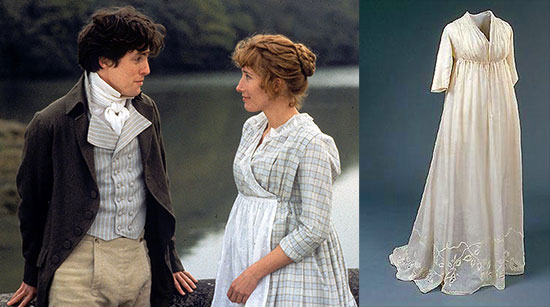
Left: Emma Thompson in Sense and Sensibility, 1995
Right: Dress, 1790s, Tidens Toj, Denmark
This dress gives the appearance of being ‘easier’ to wear than other more contrived styles of the period, and its comparable simplicity (and fact that it is often worn with an apron by Elinor) is a good indicator not only of her practical personality, but of the new economic situation her family finds itself in.
“Sense and Sensibility” (1995) is AVAILABLE to STREAM
Sense and Sensibility (2008)
Starring Hattie Morahan and Charity Wakefield
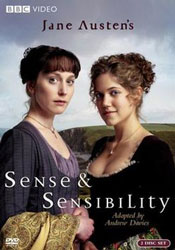 Michele Clapton (of Game of Thrones fame) designed the costumes for this latest adaptation. ‘Whilst keeping it really correct, it was the idea of playing with colour and the personalities’, she has commented. ‘To actually use colour, more than I think is often used in this period…because it was used, and so we did, probably more as highlights and accessories.’ The production designer James Merifield concurred, describing the resulting costumes as embodying a ‘homogenous, freed-up look.’(Short film: Sense and Sensibility 2008, Behind the scenes: Costumes)
Michele Clapton (of Game of Thrones fame) designed the costumes for this latest adaptation. ‘Whilst keeping it really correct, it was the idea of playing with colour and the personalities’, she has commented. ‘To actually use colour, more than I think is often used in this period…because it was used, and so we did, probably more as highlights and accessories.’ The production designer James Merifield concurred, describing the resulting costumes as embodying a ‘homogenous, freed-up look.’(Short film: Sense and Sensibility 2008, Behind the scenes: Costumes)
Colour is certainly used without hesitation, with most scenes displaying a rainbow of shades, often in the same outfit at once (always offset by Mrs Dashwood’s mourning black, which she wears throughout). Dresses are often accessorized with wide sashes of a contrasting colour and design, frequently suggesting an Indian origin or influence. A very similar aesthetic was embodied in the BBC’s Emma the following year, with a somewhat girlish freshness and casualness (including hair worn down perhaps a little too often, and a lot of relaxed posturing on the part of the female characters). All this combined, there is a rather ‘bohemian’ feel to the arrangement of the 2008 costumes, and it is not always clear whether the production is supposed to be set in the 1790s, when Austen was writing, or closer to the book’s publication date of 1811. The relatively low waistlines and skirt fullness might suggest a nod to ‘round gowns’ of the 1790s but, as with the 2005 adaptation of Pride and Prejudice, the silhouette is slimmed down and paired with accessories that could belong to a later date.
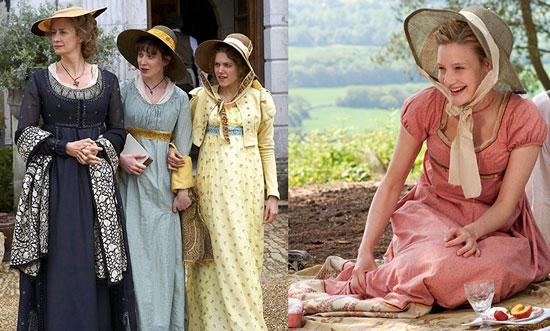
Left: Janet McTeer, Hattie Morahan, and Charity Wakefield in Sense and Sensibility, 2008
Right: Ramola Garai in Emma, 2009
It is interesting to note that this production, despite Andrew Davies’ wish to make audiences ‘forget’ the 1995 film, also adopts versions of the open robe, here worn by Elinor:
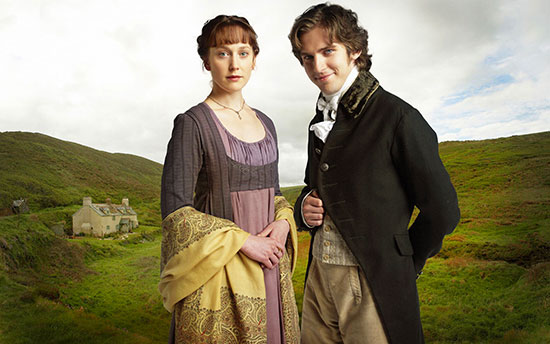
Hattie Morahan and Dan Stevens in Sense and Sensibility, 2008
The idea of freedom, of not conforming to the rigidity of fashion plates and actually ‘living’ in clothes is one that has been taken up frequently by designers in more recent productions, from Pride and Prejudice (1995) to Emma (2009). The female protagonists in Sense and Sensibility are active, intense, and forced to ‘get their hands dirty’ as their living situation so drastically changes. This sometimes results in lopsidedness, almost dishevelment; in clothes that have most certainly been ‘lived in’ – note Elinor’s neckline askew, below:
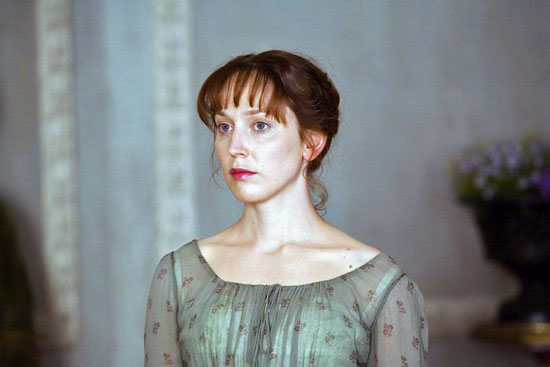
Hattie Morahan in Sense and Sensibility, 2008
A side note: It is nice to see another production tackling children’s wear for the third Dashwood sister, Margaret, who was written out of the 1971 and 1981 adaptations. At 13 years of age in the late 1790s, Margaret would have been at the tail end of her childhood, welcoming long gowns into her wardrobe at around 15 or 16. In this adaptation and the 1995 version, she seems significantly younger than Austen’s given age, and in both cases the designers seem to have clothed her as a child of around 8 – 10.
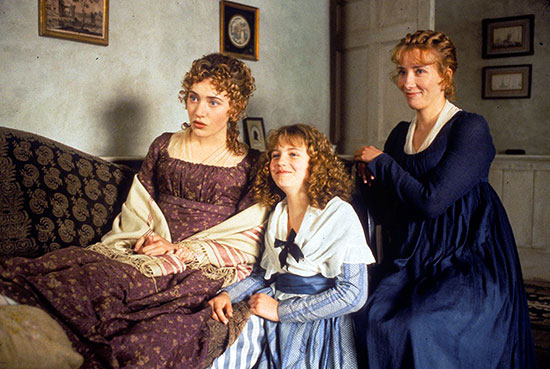
Emma Thompson, Kate Winslet, and Emilie François in Sense and Sensibility (1995)
Probably because of their significant differences in temperament, Elinor and Marianne are clothed – in all these productions – with very noticeable nods to their ages and personalities. As we have seen, Marianne most frequently wears either soft, girlish shades or bold colours to signify her passion and intensity of feeling. Of the two sisters, Elinor is the most likely to don domestic clothing, such as an apron, and take on her role as (in essence) a surrogate caregiver for the whole family.
“Sense and Sensibility” (2008) is AVAILABLE to STREAM
All the adaptations, inevitably, will leave the mark of their era on an audience, and clothes are one of the surest ways that a production will betray its contemporaneousness. However, each of these adaptations has managed (in different ways) to get across the comedy, heartbreak, and filial devotion of Austen’s original.
However, each one seems slightly unsure where to exactly place itself in terms of specific timeframe. In a single adaptation we can see influences from a range of Georgian styles, not all of which would have crossed paths in reality. Nevertheless this does create a broad education for the audience, providing them with a wide array of period features and, hopefully, a view into the mind of the designer and his/her priorities for these enduring and much-loved characters.
This article is the second in a series by Lydia Edwards for Willow and Thatch which look at the costumes in different adaptations of Jane Austen’s classics, in honor of Jane Austen 200 / the 200th year since her death. The first article, on costuming Pride and Prejudice, is here.
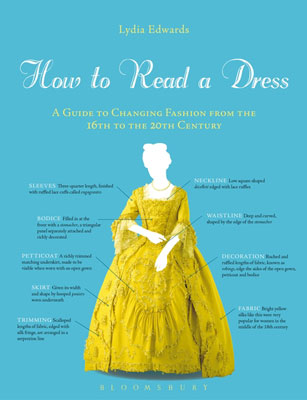 Lydia Edwards is a fashion historian and author of How to Read a Dress: A Guide to Changing Fashion from the 16th to the 20th Century. Fashion is ever-changing, and while some styles mark a dramatic departure from the past, many exhibit subtle differences from year to year that are not always easily identifiable. With overviews of each key period and detailed illustrations for each new style, How to Read a Dress is an authoritative visual guide to women’s fashion across five centuries.
Lydia Edwards is a fashion historian and author of How to Read a Dress: A Guide to Changing Fashion from the 16th to the 20th Century. Fashion is ever-changing, and while some styles mark a dramatic departure from the past, many exhibit subtle differences from year to year that are not always easily identifiable. With overviews of each key period and detailed illustrations for each new style, How to Read a Dress is an authoritative visual guide to women’s fashion across five centuries.
Each entry includes annotated color images of historical garments, outlining important features and highlighting how styles have developed over time, whether in shape, fabric choice, trimming, or undergarments. Readers will learn how garments were constructed and where their inspiration stemmed from at key points in history – as well as how dresses have varied in type, cut, detailing and popularity according to the occasion and the class, age and social status of the wearer.
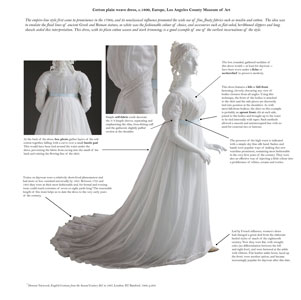 This lavishly illustrated book is the ideal tool for anyone who has ever wanted to know their cartridge pleats from their Récamier ruffles. Equipping the reader with all the information they need to ‘read’ a dress, this is the ultimate guide for students, researchers, and anyone interested in historical fashion.
This lavishly illustrated book is the ideal tool for anyone who has ever wanted to know their cartridge pleats from their Récamier ruffles. Equipping the reader with all the information they need to ‘read’ a dress, this is the ultimate guide for students, researchers, and anyone interested in historical fashion.
This original, accessible take on fashion history is packed with color images, and each example garment annotated with terminology, key elements of the shape and construction, and other details of note. -C. E. Berg, Museum of History and Industry
If you enjoyed this post, you’ll want to wander over to The Period Films List. You’ll especially like the Best Period Dramas: Georgian and Regency Era Lists. You’ll also like the Period Drama Lover’s Guide to Sense and Sensibility, and the article about Block Printed Cottons in the Georgian Era and The Jane Austen Travel Guide for suggestions of filming locations to visit when you are in England. 

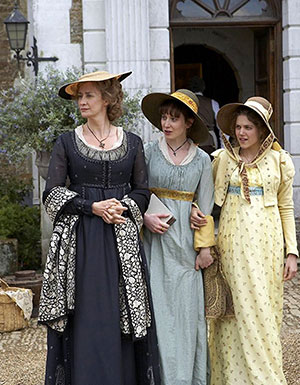
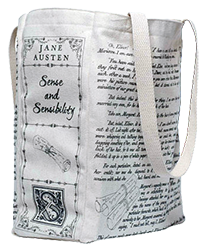
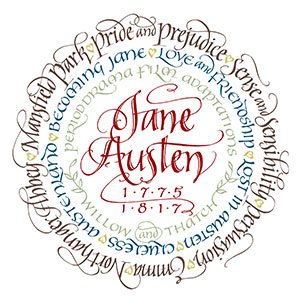


Michelle H
November 1, 2018 at 11:53 am (7 years ago)I love these articles and enjoy the historic background of the films and the knowledge shared regarding the differences in the span of years the books (written vs published) cover.
I’ve often looked at the films thinking about the costumes of the various ages and financial status of the characters. An older woman just wouldn’t be wearing the same style as their much younger counterpart. And I’ve often believed that with subtle updates, wouldn’t an older woman wear the same style she wore 10 or more years before, when she matured into the style meant for a lady of a certain age. As it is here in this era, although I don’t live in daily expectation of morning callers, and dress accordingly. I think this holds true also for women living in a small rural community. Practical ‘around-the-house’ and daily activities (domestic employment) clothing would tend to be much more comfortable and practical. I can’t see Jane or Lizzy, or Elinor or Marianne working in their still rooms, or outside tending gardens in short puffed sleeves and low necklines and willowy slim skirts. Those practical dresses didn’t change styles on a yearly basis, did they? So, I’m not surprised to see costuming on a given film spanning an enlarged time period. Or am I failing to see the point of the articles??? I definitely get the color emphasis of the costumes for different characters.
Helga
August 3, 2018 at 3:19 pm (7 years ago)I absolutely LOVE this kind of article, and would love to see many more!
Ms Edwards has done a marvelous job of dissecting the costuming of the various Sense and Sensibilities-lets have her turn fer attentions to not only other Jane Austen adaptions, but other historical films please!
Erin C
August 1, 2018 at 6:50 pm (7 years ago)There are things I love about both recent adaptations, but I’m still waiting for one that doesn’t cast Mrs. Dashwood and Colonel Brandon MUCH older than their 40 and 35, respectively.